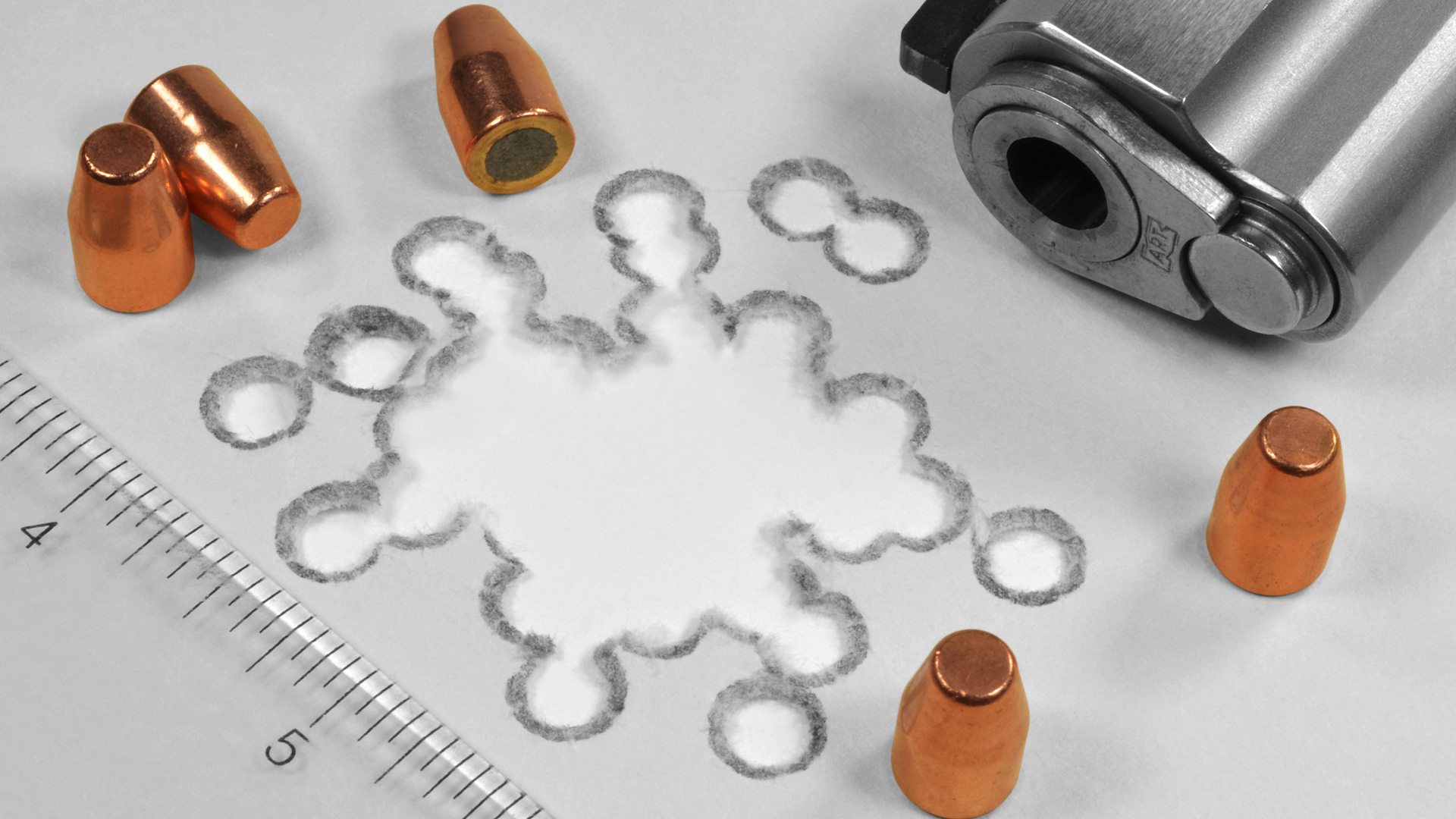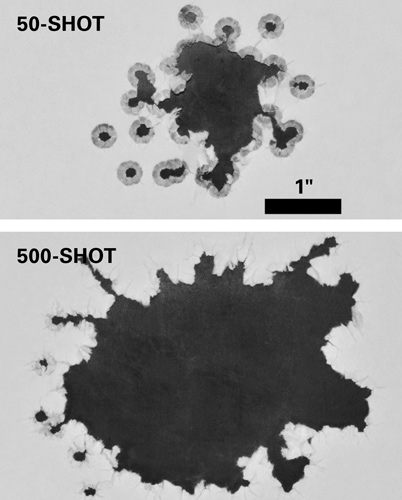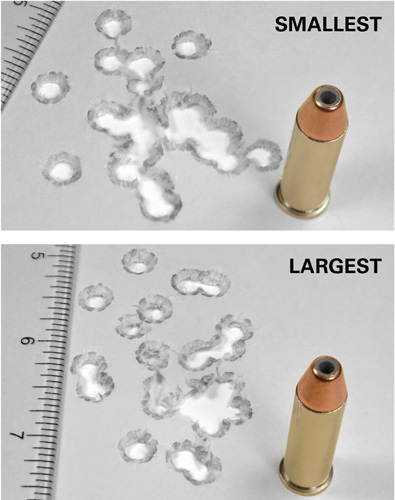
In a previous article, we looked at the value of using a 5-shot group to assess accuracy. Data showed that 5-shot groups have limitations in assessing accuracy, since their size can vary significantly, even when using the same ammunition. This article increases the number of shots in the group to assess if there is a recommended number of shots with better power to predict the aggregate group size. This will not be a theoretical discussion on sample size, rather, a practical look at actual groups from the shooting range. I’ll leave the theoretical musings to statisticians.
In Part 1, I argued that a better way to test accuracy is to shoot all your test ammo for a given load into one group because it’s easier to see the ammunition’s accuracy. The question then becomes how many rounds should that one group be? Let’s take a look at different round counts to see how they compare with aggregate groups.

A 10-shot group is another standard round count. How do their group sizes compare to the aggregate group of 50 shots? Table 1 shows five 10-shot groups of SIG 9 mm 147-grain match ammo fired at 25 yards with the gun in a Ransom Rest. These groups were shot with the same gun used in Part 1, a hybrid Para Ordnance frame with a Caspian slide and 5-inch 9 mm Kart barrel.
The smallest 10-shot group was 1.42 inches and the largest was 2.15 inches. The 50-shot aggregate group was 2.44 inches. Thus, the aggregate group was 1.7 times larger than the smallest group, and 1.1 times larger than the largest group. The smallest group was 58 percent the size of the aggregate group.

Ten-shot groups should be closer to the size of the 50-shot aggregate group than 5-shot groups. And they are in this example. Going back to the 5-shot data in Part 1, the aggregate group was 3.2 times larger than the smallest 5-shot group. Ten-shot groups are more similar to the 50-shot aggregate group. The average 10-shot group was 70 percent the size of the aggregate group. This is up from the Part 1 average of the 5-shot groups, which was 61 percent.
But none of the 10-shot groups was as large as the aggregate group. The largest 10-shot group was 88 percent of the aggregate group, the same as the largest 5-shot group was compared to the aggregate group in Part 1.
For this data set, the 10-shot groups were more consistent and, on average, a closer percentage of the 50-shot aggregate size. This makes sense because the sample size is larger than 5-shot groups. Does that hold for groups with even more shots?
15-shot groups
I have often used a 15-shot group with a “more is better” approach to round counts in groups. In a test of handloads with the same 9 mm pistol, I fired five 15-shot groups with the same ammo that produced a 75-shot aggregate group. The smallest 15-shot group measured 1.07 inch and was 35 percent of the 75-shot aggregate group size, which was 3.10 inches. The largest 15-shot group was 3.02 inches, which was 97 percent. The average group size was 2.06 inches, 66 percent of the aggregate group size.

What happened to the trend of larger shot counts better representing the aggregate group like the 10-shot groups did? Every shot is a random selection from the aggregate group. If you randomly selected 15 shots from the 75-shot group, some might be close together and some farther apart. For this reason, small groups happen by chance. That’s what happened here. The 1.07-inch group is a small group that happened by chance. The lesson is that we should not assume too much. Group size is under no obligation to meet our expectations or assumptions. More shots in your group will tend to produce group sizes that are closer to the size of the aggregate group, but small groups still happen by chance even with a higher round count.
24-shot groups

This series of data was shot with a revolver (S&W Model 67, .38 Spl., 4-inch) in the Ransom Rest. Eight 24-shot groups were fired at 25 yards for a total of 192 rounds, all with the same ammo. The smallest group was 1.90 inches, and the largest was 3.65 inches. The largest group was 1.9 times larger than the smallest group.
The 192-round aggregate group was 3.65 inches, the same as the largest 24-shot group and the first time with the data presented here that a subgroup matched the size of the aggregate group. The smallest group was 52 percent of the size of the aggregate group.
50-shot groups

Ten 50-shot groups were fired from the Ransom Rest, producing a 500-shot aggregate group. Again, I used the 9 mm Para/Caspian Kart barrel gun with factory Winchester 115-grain FMJ round-nose ammo from the same lot number.
The smallest 50-shot group was 2.66 inches (group 1) and the largest was 4.41 inches (group 10). The largest group was 1.7 times larger than the smallest group. None of the 50-shot groups were as large as the 500-shot group, which measured 4.67 inches. This group was 1.8 times larger than the smallest 50-shot group, and 1.1 times larger than the largest.
In this case, firing more shots resulted in a larger group all the way up to 500 rounds. Even 50-shot groups with the same ammunition vary in size. In percent value, the smallest 50-shot group was 57 percent the size of the aggregate group. That’s awfully close to a 50-shot group being only half the size.
There was one curious thing about the 50-shot group test. The table shows the groups in the order they were fired. With one exception, the groups grew larger as more were fired. The barrel was cleaned after every 50 rounds, so it can’t be blamed on a dirty barrel. The gun didn’t get increasingly hot. It was fired on a cool day at a normal pace. I stopped shooting every couple rounds to write down the velocity for all 500 rounds. The barrel was removed for cleaning. It wasn’t hot, and there was enough time for it to cool down to the same general temperature at the start of every string. The gun didn’t become loose in the Ransom Rest inserts. The Ransom Rest did not become loose from the table to which it was clamped. The groups were getting larger as they were fired, and I was consciously looking for reasons that might explain it. Everything seemed to be normal.

What does all this testing tell us? First, not all groups with the same number of shots with the same ammo are the same size. This applies even up to 50-shot groups. There can be a big difference between the sizes of the smallest and largest groups. With the data presented in these two articles, using the same ammunition there can be up to a 2.8 times difference between the smallest and largest groups. And when considering the aggregate group, the smallest group has been up to 3.2 times smaller.
A small sample of shots can misrepresent accuracy by a large degree. More shots in a single group, generally, are better able to paint a clearer picture of accuracy. That said, small groups can and do happen by chance. The smallest groups recorded in the 5- and 15-shot groups were roughly a third the size of the aggregate group.
Even with a lot of shots in the group, they still might not be that close in size to the aggregate group. For example, the smallest groups with the 10-, 24- and 50-shot groups were just over half the size of the aggregate group.

Keep this in mind when thinking about data—the group size we get with lots of shots in one group is just a sample of an aggregate group we would get with more shots. Our sample group size could be close to the aggregate group size, or not so close. This does not invalidate using more shots in our group, it just means we have to accept it as a fact of accuracy testing.

We would like to think that the more rounds we include in our group, the closer it gets to representing the aggregate group. There is some truth to that, because there is a trend for the average size of the groups to be closer to the size of the aggregate group. As shown in the table, the average size of the 5-shot groups was 61 percent of the size of the aggregate 50-shot group, and the average size of the 50-shot groups was 78 percent the size of the 500-shot aggregate group.
A larger number of shots in a group should decrease the chance that it will be unusually small relative to the aggregate group. However, we’re dealing with probability, and a small group is still probable even with a large round count.
How many rounds?
I won’t tell you that X number of rounds are required. Instead, the information here is to help you understand the advantages of shooting more rounds and also their limitations. Fifty-shot groups seem like they should be more than enough to tell you how your gun likes the ammunition, but we learned that even 50-shot groups with the same ammo can be different sizes.
Whatever number of shots you select for your accuracy tests, be aware that there are potential limits to how far you can interpret your results.


































